 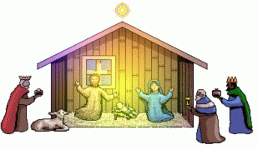 The Bible says that wise men travelled from afar on camels to visit the infant Jesus as he lay in the manger. They brought him gifts of gold, frankincense and myrhh. We all know what gold is, but have you ever wondered what frankincense and myrrh were? Frankincense and myrrh are both resins ... dried tree sap... that come from trees of the genus Boswellia (frankincense) and Commiphora (myrhh), which are commonly found in northern Africa and the Middle East. Frankincense and myrrh have always been used to create incense, a substance you burn to create pleasing aromas. The sap from these two trees is collected in a similar way that people collect rubber-tree sap or pine-tree sap. Cutting the tree's bark causes the sap to flow out of the cut. It's allowed to dry on the tree, and then it's collected. Frankincense 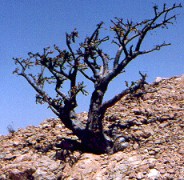 Frankincense is obtained from trees of the genus Boswellia found in Somalia and Saudi Arabia. The trees grow on the rocky coast; the youngest trees furnish the most valuable sap. The season for gathering dried sap lasts from May till the middle of September. Frankincense is obtained from trees of the genus Boswellia found in Somalia and Saudi Arabia. The trees grow on the rocky coast; the youngest trees furnish the most valuable sap. The season for gathering dried sap lasts from May till the middle of September. 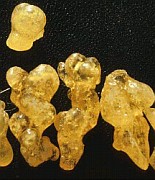 The milk-like juice runs from a cut made in the bark and is allowed to harden. After about three months the sap dries into yellowish 'tears'. These clear globules are scraped off. Frankincense is mixed with spices, seeds and roots to create different aromas. Traditionally, you burn a powdered form of the incense with charcoal in a censer or on a small stand. 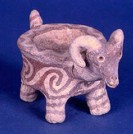 A censer is a vessel for burning incense. A typical censer is a small metal or stone dish. In many cultures, burning incense has spiritual and religious connotations, and this influences the design and decoration of the censer. Designs vary from simple, earthenware bowls to intricately carved silver or gold vessels. Myrrh 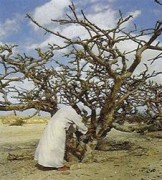 Commiphora is a shrub or small tree found in the desert areas of North Africa (primarily Somalia) and the Red Sea shores of Saudi Arabia. It grows up to 3 m tall and has tough, knotted branches. The sap, or resin, is a pale yellow liquid, and it flows slowly from cuts in the bark. After it dries it is collected in reddish-brown irregular lumps. The word myrrh means 'bitter' in Arabic. Commiphora is a shrub or small tree found in the desert areas of North Africa (primarily Somalia) and the Red Sea shores of Saudi Arabia. It grows up to 3 m tall and has tough, knotted branches. The sap, or resin, is a pale yellow liquid, and it flows slowly from cuts in the bark. After it dries it is collected in reddish-brown irregular lumps. The word myrrh means 'bitter' in Arabic.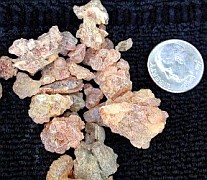 Myrhh has been used for ages as an ingredient in incense, beauty treatments, and perfumes. it also makes a good glue. Writings from 2,700 years ago describe how myrrh was also used for embalming. Because the demand for myrhh eventually became so high, and because its supply was limited, myrrh became as valuable as gold. You might also be interested in what the Bible actually tells us about the three wise men and the gifts they brought. Surprisingly, not a lot of information is given. Mathew 2:1 tells us: Matthew doesn't say how many wise men came from the east, doesn't mention their names, and doesn't provide any details about how they made their journey. Matthew 2:1-2 tells us that they came "from the east" to worship the "king of the Jews". It has generally been assumed that there were three wise men because Matthew 2:11 makes mention of three gifts: " . . . they presented unto him gifts; gold, and frankincense and myrrh". The names of the wise men, Gaspar, Melchior, and Balthasar, don't come from the Bible; in fact, these names didn't appear in Christian literature until over 500 years after the birth of Jesus. Nothing in the Bible says the wise men rode camels or any other animal; they may in fact have walked. And despite the familiar lyrics of the Christmas carol 'We Three Kings', no biblical source depicts the three wise men as kings. Their identification as kings is probably linked to Isaiah 60:1–6, which refers to "kings [coming] to the brightness of your dawn" bearing "gold and frankincense". Further identification of the magi with kings may be due to Psalm 72:11, "May all kings fall down before him". We can assume, however, that they were most likely highly learned men, perhaps astrologers. In any case, they knew a miracle had occurred. Matthew 2:1–12 describes the visit of the Magi: "In the time of King Herod, after Jesus was born in Bethlehem of Judea, wise men from the East came to Jerusalem, asking, 'Where is the child who has been born king of the Jews? For we observed his star at its rising, and have come to pay him homage.' When King Herod heard this, he was frightened and all Jerusalem with him; and calling together all the chief priests and scribes of the people, he inquired of them where the Messiah was to be born. They told him, 'In Bethlehem of Judea; for so it has been written by the prophet: 'And you, Bethlehem, in the land of Judah, are by no means least among the rulers of Judah; for from you shall come a ruler who is to shepherd my people Israel.'' Then Herod secretly called for the wise men and learned from them the exact time when the star had appeared. Then he sent them to Bethlehem, saying, 'Go and search diligently for the child; and when you have found him, bring me word so that I may also go and pay him homage.' When they had heard the king, they set out; and there, ahead of them, went the star that they had seen at its rising, until it stopped over the place where the child was. When they saw that the star had stopped, they were overwhelmed with joy. On entering the house, they saw the child with Mary his mother; and they knelt down and paid him homage. Then, opening their treasure chests, they offered him gifts of gold, frankincense, and myrrh. And having been warned in a dream not to return to Herod, they left for their own country by another path" |